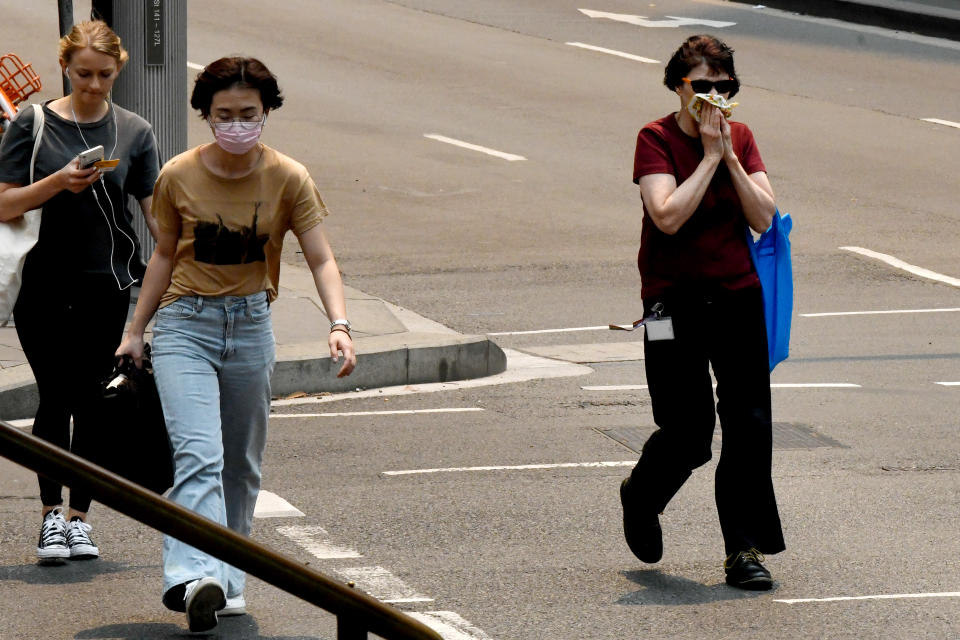'Recipe for severe illness': Sydney air quality plummets as firies prepare for blistering heatwave
Residents in Sydney have awoken to the city once again blanketed in thick smoke, prompting health warnings for vulnerable people.
A smoky haze has descended across Sydney, bringing poor air quality to much of the city as roughly 80 fires continue to burn across NSW, of which 35 are yet to be contained.
The Bureau of Meteorology says “severe heatwave conditions” will build up on Tuesday, bringing temperatures over 40 degrees to many regions.
These conditions, combined with “grotty” smoke pollution, will put a lot of stress on vulnerable people in the coming days, NSW authorities have warned.
Sydneysiders are battling air quality on Tuesday that is rated severely hazardous. Those in the southwestern and northwestern suburbs on Tuesday faced air quality readings five times worse than hazardous levels.
NSW Health environmental health director Dr Richard Broome says Tuesday is set to be “very hot and very smoky”.
“It's going to be putting a lot of stress on vulnerable people, particularly elderly people who have existing heat and lung conditions.”

Conditions a ‘recipe for severe illness’
Dr Broome said people should avoid doing strenuous activity outside if they could.
“Hot weather and poor air quality are a recipe for severe illness unless people take simple precautions.
“We are urging people to avoid being outside during the hottest part of the day, to minimise physical activity, to keep well hydrated and reduce their exposure to smoky air,” Dr Broome said.
“Hot weather puts a lot of strain on the body, causes dehydration and can make underlying health conditions worse. It also causes heat stress and heat stroke.
The NSW environment department says poor air quality in Sydney on Tuesday could “cause symptoms, especially in people with heart or lung disease”.
Dr Broome urged people to check on neighbours who might be considered at risk.
“It’s also really important to stay in regular contact with elderly neighbours, friends and relatives because they may be more vulnerable to the heat.
“Signs of heat-related illness include dizziness, tiredness, irritability, thirst, fainting, muscle pains or cramps, headache, changes in skin colour, rapid pulse, shallow breathing, vomiting and confusion,” he said.
'Paradise turns to hell': Family watching TV sees bushfire engulf property
Outrage after unthinkable happens to NSW fire station amid bushfire emergency

“Air quality across NSW may be affected by extensive smoke from bushfires, in particular, the mid-North Coast, Northern Rivers and Northern Tablelands regions,” the department said.
The NSW government’s Real-time Air Quality Index (AQI) reveals smoke pollution on Tuesday morning was the worst in the northwest parts of Sydney with Penrith and Richmond areas registering the highest level of “hazardous” air pollution.
The AQI is calculated from air quality data for five pollutants and visibility readings including carbon monoxide, sulfur dioxide, nitrogen dioxide and airborne particles, and gives residents a quick way to gauge the air quality on a given day.
An AQI of 100 corresponds to a national standard in line with the National Environment Protection Council, and levels above 100 signify “poor” air quality and trigger health warnings. Anything above 200 is deemed hazardous.
On Tuesday morning, Sydney’s west, northwest, and the city’s east all registered readings more than five times the hazardous level, with readings reaching well above 1000.
In Sydney the smoke was expected to be at its worst in the morning, before light winds helped ease the smoky conditions along with the chance of a thunderstorm in the afternoon or evening, the Bureau of Meteorology said.
Total Fire Bans are now in place for nine areas across the state with a Very High to Severe fire danger forecast, the NSW Rural Fire Service said at about 7:30am Tuesday morning.
Once again, many people took to social media to post photos of the ‘barely visible’ city skyline, lamenting the harmful conditions.
things are not good pic.twitter.com/2mpm9KelUO
— Rohan Pearce (@rohan_p) December 9, 2019
#Sydney barely visible through the bushfire smoke. Temperatures forecast to reach 36C in the city, 42C in the west. #NSWfires pic.twitter.com/kqAnlDmSLB
— Peter Hannam (@p_hannam) December 9, 2019
Wind change expected as NSW mega fire rages
NSW Rural Fire Service Commissioner Shane Fitzsimmons says wind speeds on Tuesday won't be as high as previous dangerous bushfire days, but high temperatures and low humidity would cancel this out.
Firefighting crews spent Monday evening back-burning around the Gospers Mountain mega-fire on the Central Coast.
“We're going to see this hot, dominant air mass moving across into NSW, but particularly hot conditions with really dry air is going to result in some fairly widespread severe fire danger ratings,” Mr Fitzsimmons told the Seven Network.
“We're quite concerned about the potential for fire danger and fire spread today.”

“We are going to see a vigorous cold front move through the state and particularly start moving through places like Sydney in the early afternoon, up through the Hunter a little later in the afternoon, into the evening.”
Mr Fitzsimmons said the southerly cold front could ramp up fires surrounding Sydney by dramatically changing wind direction. The RFS was conducting critical operations to protect homes, he said.
Nine regions are under total fire bans on Tuesday, including greater Sydney, greater Hunter and Illawarra-Shoalhaven.
Do you have a story tip? Email: newsroomau@yahoonews.com.
You can also follow us on Facebook, Instagram and Twitter and download the Yahoo News app from the App Store or Google Play.



